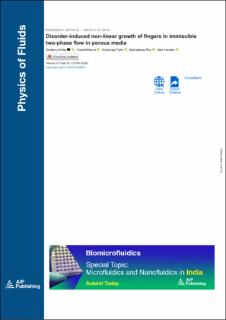| dc.description.abstract | Immiscible two-phase flow in porous media produces different types of patterns depending on the capillary number Ca and viscosity ratio M. At high Ca, viscous instability of the fluid–fluid interface occurs when the displaced fluid is the more viscous, and leads to viscous fingering, which is believed to exhibit the same growth behavior as the viscously-unstable fingers observed in Hele–Shaw cells by Saffman and Taylor [“The penetration of a fluid into a porous medium or Hele–Shaw cell containing a more viscous liquid,” Proc. R. Soc. London 245, 312 (1958)], or as diffusion-limited aggregates (DLA). In such Laplacian growth processes, the interface velocity depends linearly on the local gradient of the physical field that drives the growth process (for two-phase flow, the pressure field). However, a non-linear power-law dependence between the flow rate and the global pressure drop, reminiscent of what has also been observed for steady-state two-phase flow in porous media, was evidenced experimentally for the growth of viscously-unstable drainage fingers in two-dimensional porous media, 20 years ago. Here, we revisit this flow regime using dynamic pore-network modeling and explore the non-linearity in the growth properties. We characterize the previously unstudied dependencies of the statistical finger width and non-linear growth law's exponent on Ca, and discuss quantitatively, based on theoretical arguments, how disorder in the capillary barriers controls the growth process' non-linearity, and why the flow regime crosses over to Laplacian growth at sufficiently high Ca. In addition, the statistical properties of the fingering patterns are compared to those of Saffman–Taylor fingers, DLA growth patterns, and the results from the aforementioned previous experimental study. | en_US |

